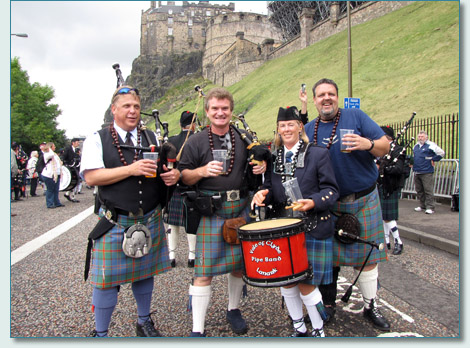SCOTLAND
See Also: The History of Scotland
Our own Hamish Burgess broadcasts a weekly radio show across Glasgow, Scotland:
Tuesdays - the Maui Celtic Radio Show is on Celtic Music Radio 95FM across Glasgow, Scotland from 11am-1pm GMT, streaming at www.celticmusicradio.net.
The show will be online Tuesday's - local time for the summer 12-2am (Hawaii), and mainland 3-5am US/Canada West coast, 4-6pm Mountain time, 5-7am Central time, 6-8am Eastern Standard Time, Canadian Maritimes 7-9am, Newfoundland 7.30-9.30am, and 11am - 1pm in Ireland and the UK, Europe 12-2pm. Chat with Hamish (if he's up!) during the show on Facebook at The Maui Celtic Show page. Many thanks to show underwriters The Irish Rovers.
Scotland is now a recognised separate country of the U.K., with its own parliament. In 2009 Hamish Burgess of Maui Celtic attended the first ever Clan Convention, at the Scottish Parliament (Pàrlamaid na h-Alba) building, where over 100 Scottish Clan Chiefs and clan dignitaries from around the world discussed the role of the Clans in the modern world.
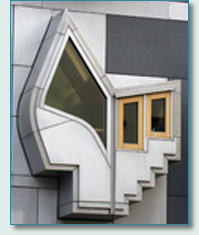 The Scottish Parliament new building sits at the bottom of Edinburgh's famous Royal Mile, near Holyrood Park and under Salisbury Crags and Arthur's Seat. The steel, oak, and granite complex was designed by architect Enric Miralles, inspired by the surrounding landscape, flower paintings by Charles Rennie Mackintosh, and upturned boats on the seashore. A unique feature is the wall of 114 projecting bay windows (shown right) of the Members of Scottish Parliament office building. Termed 'contemplation spaces' by the architect, internally each has a window seat and fitted shelving.
The Scottish Parliament new building sits at the bottom of Edinburgh's famous Royal Mile, near Holyrood Park and under Salisbury Crags and Arthur's Seat. The steel, oak, and granite complex was designed by architect Enric Miralles, inspired by the surrounding landscape, flower paintings by Charles Rennie Mackintosh, and upturned boats on the seashore. A unique feature is the wall of 114 projecting bay windows (shown right) of the Members of Scottish Parliament office building. Termed 'contemplation spaces' by the architect, internally each has a window seat and fitted shelving.
Hamish Douglas Burgess at the Clan Convention, Scottish Parliament, Edinburgh 2009
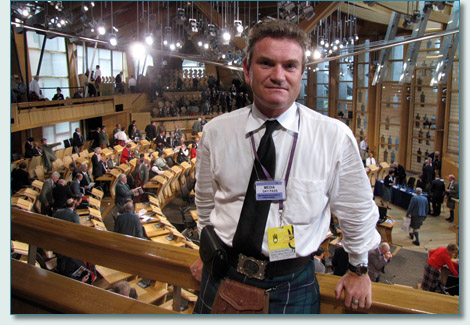
Scotland is a land of unparalleled beauty. The rolling green hills of the Southern Uplands fade to the central plain, containing the ancient towns and cities, age old hubs of art and culture, before rising again to become the majestic Highlands, homelands of the oldest Clans. From dramatic cliffs and coastline cut by sea lochs, in sight of hundreds of offshore islands set in clear blue water, to deep inland lochs inhabited by mythical beasts, and surrounded by purple heather-clad mountains, the scenery is spectacular.
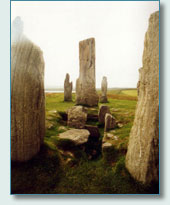 The ancient stone circles, burial mounds and medieval
castles are never far away. Left - Calanais Standing Stones
The ancient stone circles, burial mounds and medieval
castles are never far away. Left - Calanais Standing Stones
The old name for this land was Alba, or Albainn, then 'Scotia' and the Romans called it 'Caledonia'. The Picts originally lived in what is now Scotland, given the name 'Pictii' by the Romans, which meant 'painted people' - they were heavily tattooed (for an article on this, go to the bottom of the celtic art page), and preferred to fight almost naked to enable them to move quicker in battle. The only legacy of these mysterious people are their symbol-carved stones, which stand all over Scotland, especially in the north-east.
The Scots arrived from the north-east coast of Ireland in the early 500s, from their homeland Dalriata, and settled in the south-west of Pictland , establishing the Kingdom of Dalriada. The name Scots was from 'Scotii', which meant 'raiders/plunderers'. For the next 200 or so years they expanded their territory north and east, alternately warring, mixing, and intermarrying with the Picts until 844, when the Scots King Kenneth MacAlpin united the 2 races under one king. After this, Pictish identity faded into mystery.
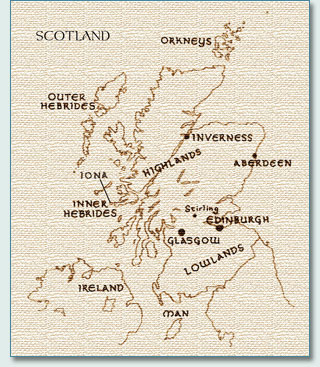
By the late 700s the Vikings were raiding all these lands, and by the middle 9th century occupied the Shetland Islands, the Orkneys, the Hebrides, and the Isle of Man, forming a massive offshore kingdom, the Kingdom of the Isles. Pictish and Scottish kings were traditionally crowned and buried on the sacred Isle of Iona, off the Isle of Mull.
In the 930s the Saxons invaded Alba but were later driven out. 1034 was the first time that the term 'Scotia' had been used to describe the nation. Duncan was the first King of Scotia, later killed by MacBeth, the story being made into a play hundreds of years later by William Shakespeare.
38 years later William the Conqueror came north, defeating the Scottish king and making him pay homage, the start of hundreds of years of trouble between the countries. King David united the country, but in 1165 a failed invasion of England caused a treaty of homage for the entire kingdom, and southern Scotland's castles were to be garrisoned with English soldiers.
100 years of relative peace followed, until the death of Alexander 3rd left Scotland with no king, and John Balliol and Robert Bruce both claimed the throne. Edward 1st of England was called upon to decide, and chose Balliol, only to invade 4 years later and occupy Scotland. 1297 saw the rise of William Wallace, future national hero, victor at Stirling Bridge and a thorn in the English side for years. In 1305 he was betrayed by men of his own country and captured, tried in London and executed - hung, drawn and quartered.
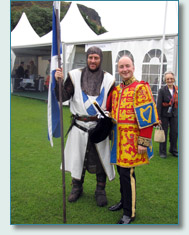 In 1306
Robert Bruce, grandson of the original claimant to the throne, declared himself
king, and on June 24th, 1314, at the Battle of Bannockburn, destroyed the English
army. Scotland regained her freedom. This was asserted in the Declaration of Arbroath
in 1320, and Scotland was internationally recognised as an Independent Nation
in 1328.
In 1306
Robert Bruce, grandson of the original claimant to the throne, declared himself
king, and on June 24th, 1314, at the Battle of Bannockburn, destroyed the English
army. Scotland regained her freedom. This was asserted in the Declaration of Arbroath
in 1320, and Scotland was internationally recognised as an Independent Nation
in 1328.
'Robert the Bruce' at The Gathering in Edinburgh in 2009, with his descendant the Lord of Elgin and Kincardine, son of the Chief of the Bruce Clan, nearby the Bruce tent (shown left).
The next several hundred years was a time of changing kings and regents, with the Bruce line followed by the Stewart line.
Upon the English Queen Elizabeth's death in 1603, King James 6th of Scotland succeeded to the English throne. Ironically a Scotsman was now King James 1st of England. This was a time of complicated religious reform in both countries, causing friction between the people of 2 countries and their king. The dissatisfied English parliament turned on him, and Oliver Cromwell led the 'Roundheads' against the Royalists in the English Civil War, and upon winning executed King Charles Stewart. The Stewarts fled to the Continent, and were replaced by the Dutchman William of Orange.
The Act of Union was passed in 1707, and George 1st from Hanover succeeded Queen Anne to the combined throne of 'Great Britain'. 1715 saw the first royalist Jacobite Rebellion, in support of the exiled Stuart King James, crushed by government troops. The 1745 Rebellion started when "Bonnie Prince Charlie", Prince Charles Edward Stuart, landed in Scotland to reclaim his father's throne, raising his standard at Glenfinnan, and rallied an army of Highlanders. They had several victories, and even invaded England, getting as far as Derby, only 120 miles from London!! But starving and faced with a huge army, they returned to Scotland, and in 1746 the Jacobite army made its last stand at Culloden Moor and was destroyed. The government victory prompted an act banning the traditional highland Gaelic speech, the wearing of Tartan, and playing the bagpipes (regarded as an "instrument of war").
Na Fir Dileas (The Loyal Men), a Jacobite organisation - The Gathering 2009
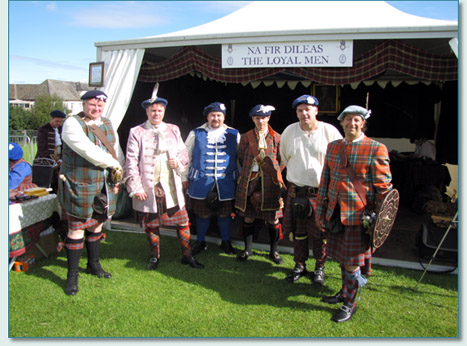
During the 18th century the ancient Celtic clan system in the Highlands began to break down. The Highland Clearances began in the 1760s, with massive amounts of poverty stricken Scots going overseas, many forced off their land. Whole communities were shipped to Canada, and some emigrated to America, Australia, and New Zealand. Many ruined clearance cottages can be seen all over the Highlands today.
In total contrast, the turn of the 18th to 19th century saw the 'Age of Enlightenment', with Edinburgh becoming the European centre of the arts, literature, philosophy, and the sciences, medicine, engineering and invention. Scots gave us steam power, gaslight, the telephone, logarithms, pneumatic tyres, television, anaesthesia, penicillin, and tarmac, also bicycles, beta blockers, golf and curling. Many inventions are still in use everyday. The Industrial Revolution saw a boom in engineering and manufacturing. Coal mining peaked in the 1890s, and Scotland was a world leader in shipbuilding.
The Scottish National Party started in 1934, and many years later their efforts paid off. Scotland now has its own Parliament, and the Stone of Destiny was repatriated from under the English throne in London in 1996, 700 years after Edward 1st took it there, now on display in Edinburgh Castle alongside the Honours of Scotland. A much more detailed version of the above can be found on our Scottish history page.
Alan and Hamish at Loch Tay Crannog Center
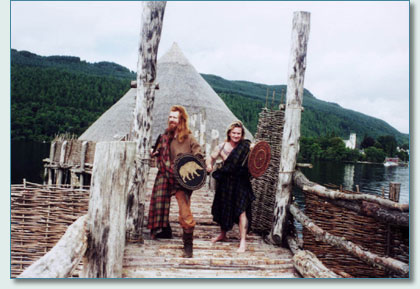
Saint Andrew is the Patron Saint of Scotland, and St. Andrew's Day is celebrated by Scots all over the world on November 30th.
St Andrew's Day (Andermass), originally a religious day to remember the first Apostle, is now a day dedicated to celebrating Scottish traditions and culture. St Andrew's Day festivities in Scotland and abroad often feature Scottish traditional food, music, songs, poetry and dance.
It tends to be more popular with Scots who live abroad and there are many St. Andrew's Societies in places where Scots emigrated to. These days, with 28 million people of Scottish heritage around the world, glasses will be raised to toast Scotland and St Andrew on every continent.
The St. Andrew's Society in Boston, in the USA, was set up in 1657.
There is a "St.Andrew's Society of Hawai'i" in Honolulu - please visit The Saint Andrew Society of Hawaii.
St. Andrew's Day used to be a very popular feast day in Scotland, and it was a common custom for farm workers and labourers to go "St. Andra'ing". They would catch rabbits and hares and later on in the day would feast and drink.
Very little is known about St. Andrew himself. He was said to have been a fisherman in Galilee (now in Israel), along with his older brother Simon Peter (Saint Peter). Both men became apostles of Jesus. St. Andrew is said to have been responsible for spreading the Christian religion through Greece and Asia Minor. Legend has it that St. Andrew was crucified to death by the Romans in Patrae, Southern Greece. It is said that he preached for two days from the cross. Legend has it that the cross was diagonal shaped, and is said to be the basis for the Cross of St. Andrew which appears on the Scottish Flag.
In early Christian days the bones of saints, and other articles that they carried, were preserved. This showed later disciples that the Saints were real people, no matter how legendary they became. The preserved bones and objects are called relics, and often split up distributed to different churches. 400 years after being entombed, St. Andrew's bones were moved by Emperor Constantine (the Great) to his new capital Constantinople (now Istanbul in Turkey).
Legend has it, that a Greek monk (though others say an Irish assistant of St. Columba) called Regulus, was warned by an angel in a dream that St. Andrews remains were to be moved, and told him to take whatever remains he could to the "ends of the earth" for safe-keeping. Regulus faithfully did as told, taking a tooth, an arm bone, a kneecap and some fingers from St. Andrew's tomb and taking them as far away as possible. Scotland was at the end of the known world at that time, and Regulus was shipwrecked there with his precious cargo. Legend says he landed at a Pictish settlement at Muckross (East Coast of Scotland), built a church, and buried the relics of St.Andrew under the altar. Regulus became a saint years later, (St.Regulus or St.Rule), and his church was known as Cill Rimhinn or Kilrymont (the hill of the church of Regulus). It is now called St. Andrews.
St. Andrews Cathedral, city, college and golf course from atop St.Rule's Tower
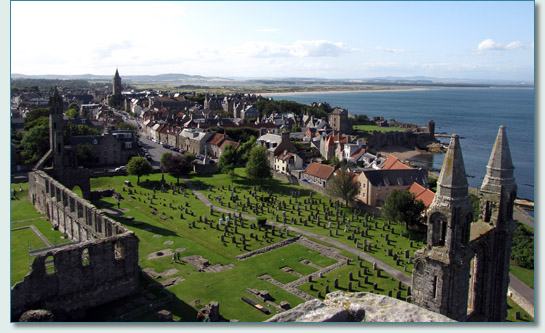
A totally different story tells of Acca, the Bishop of Hexham, a renown collector of relics, who brought the relics of St. Andrew to that church in 733. There was a religious centre at St. Andrews at that time, either founded in the 6th century by St. Rule, or by a the Pictish King Ungus, who ruled from 731 - 761. Either way, the relics were housed in a specially built chapel, replaced by the Cathedral of St. Andrews in 1160. St. Andrews became a great centre for Medieval pilgrims who came to view the relics, and the religious capital of Scotland. St. Rules Tower is still today amongst the ruins of St. Andrews Cathedral.
The whereabouts of the relics of St. Andrew are unknown today, but it is quite likely that they were destroyed during the Scottish Reformation.
There is a plaque amongst the ruins of the the Cathedral at St. Andrews marking the place where these relics were kept.
Most of St. Andrew's remains were stolen from Constantinople in 1210 and are now in Amalfi in Southern Italy. In 1879 the Archbishop of Amalfi sent a small piece of the Saint's shoulder blade to the Roman Catholic Church in Scotland. In 1969, Pope Paul VI gave Gordon Gray, leader of the Roman Catholic Church in Scotland (in Rome to be appointed the first Scottish Cardinal since the Reformation), more relics of St. Andrew and said "Saint Peter gives you his brother". They are now displayed in Edinburgh in St. Mary's Roman Catholic Cathedral.
The Scottish flag, the Saltire, also the term for a diagonal cross, is St.Andrews Cross. The flag is said to have originated from a dream of the Pictish King Angus, in A.D.761, the night before a battle with a British tribe. St.Andrew appeared to him, bearing his silver diagonal cross, showing against a blue sky, and promised that he would survive and be victorious in battle. King Angus vowed that if this came true he would adopt Saint Andrew as the patron saint of Alba. Legend has it that when the two armies met the next day, that a white cloud shaped like a diagonal cross, or a saltire, formed against the blue sky. This encouraged the Picts to triumph on the battlefield, killing Athelstan and routing the Angle army.
The Saltire was adopted as the emblem of Scotland and Saint Andrew became the national Saint. The flag represents the silver cross (now in white) on a blue field. The flag also became the inspiration for the flags of two Canadian provinces, Nova Scotia and Newfoundland.
The other flag often seen used to represent Scotland,
the red rampant lion on a yellow field, is not the national flag, but the Royal
Standard of Scotland, used by whoever was king or queen at any time. It was probably
first used in the 12th century, and for many centuries could only be used by the
Royal family.
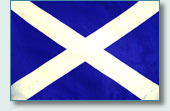
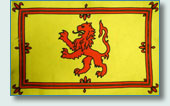
Maui folks Mike, Hamish, Alice and Jason at Pipefest March, Edinburgh 2010
proudly sporting their Hawaii Tartan kilts and kukui nut leis
